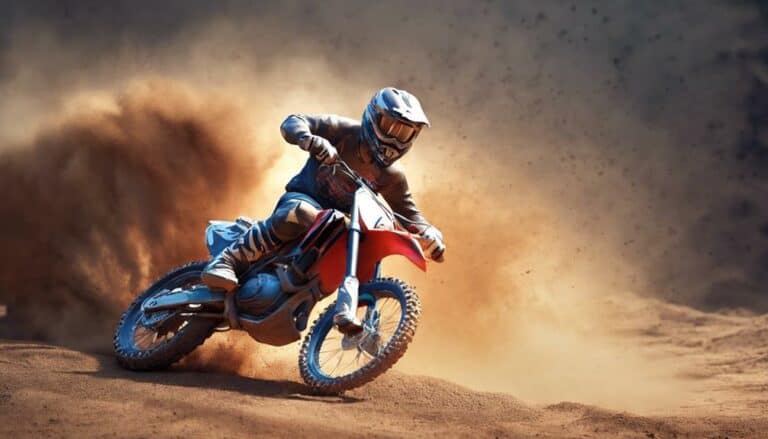When approaching a tight turn on a dirt bike trail, imagine this scenario: you lean your body forward, shift your weight to the front end of the bike, and use your inside leg for balance.
These techniques are just the tip of the iceberg when it comes to mastering tight turns on the trail.
Stay tuned to discover more effective strategies that can help you navigate those challenging curves with confidence and skill.
Key Takeaways
- Lean forward and use body positioning to distribute weight for control in tight turns.
- Employ both front and rear brakes with finesse to maintain stability and control.
- Focus on the exit point, choose smooth paths, and scan terrain for optimal line selection.
- Master throttle control, feathering for adjustments, and steady acceleration out of the turn.
Body Positioning for Tight Turns
When tackling tight turns on a dirt bike trail, your body positioning plays an important role in maintaining control and stability. As you approach a corner, focus on shifting your weight towards the front of the bike. By leaning forward, you help distribute weight over the front wheel, enhancing traction and steering response. Keeping your body centered over the bike's front end allows for better control through the turn.
To further optimize your maneuverability, utilize your inside leg to guide the bike through the corner. This technique helps maintain balance and aids in steering the bike along the desired path. By positioning your body towards the front and center of the bike, you maximize stability and control, enabling you to navigate tight turns with confidence.
Remember to maintain a low, crouched position to lower your center of gravity, enhancing stability and improving your ability to negotiate challenging corners. Practice shifting your weight and adjusting your body positioning to smoothly navigate tight turns on dirt bike trails, mastering the art of control through precise front-focused movements.
Braking Techniques for Control
To enhance your control and stability when maneuvering tight turns on a dirt bike trail, what braking techniques should you employ for peak performance?
When it comes to braking in tight turns, it's important to use both your front and rear brakes in combination. By applying gentle pressure on the brakes, you can prevent skidding and maintain traction, allowing you to modulate your speed effectively while negotiating the turn.
Practice braking before entering the turn to make certain you have the right speed and position. Remember to keep your body position balanced and distribute your weight appropriately, with a focus on keeping weight on the front. This technique helps to maintain control and stability throughout the turn, allowing you to navigate through tight corners with confidence.
Vision and Line Selection
Maintain a wide visual perspective ahead and carefully select your line to anticipate obstacles and guarantee superior traction through tight turns on a dirt bike trail.
When approaching a tight turn, focus your gaze on the exit point to plot your line effectively. Choose the smoothest path, avoiding ruts that could unsettle your front end and compromise traction.
By keeping your eyes up and level, you enhance your balance and control, essential for maneuvering challenging bends. Utilize your peripheral vision to scan the terrain, enabling swift adjustments to your line if unexpected obstacles arise.
A proactive approach to vision and line selection is key to successfully maneuvering through tight turns with confidence.
Throttle Control in Turns
Ensure precise throttle control as you navigate tight turns on your dirt bike trail to optimize speed, traction, and stability. Whether you're sitting or standing, maintaining a steady throttle through the turn is vital. This steady throttle helps you control your speed and traction, allowing you to smoothly maneuver through the turn. In addition to this, feathering the throttle can help you adjust your bike's trajectory, preventing any unwanted sliding. Avoid sudden throttle inputs that could lead to the rear wheel breaking loose, which can destabilize your bike in the turn.
Using the throttle effectively isn't just about entering the turn; it's also about exiting it. By smoothly powering out of the turn with controlled throttle inputs, you can maintain your momentum and carry speed into the next section of the trail. Practice throttle control in various types of tight turns to hone your skills and build confidence in your ability to handle any challenging terrain.
Practicing Tight Turns Techniques
When practicing tight turns techniques on your dirt bike trail, focus on mastering counterbalancing for improved stability and control. Counterbalancing involves leaning the bike slightly in the opposite direction of the turn, which helps you stay balanced and in control.
Additionally, proper body positioning plays an important role in managing tight turns effectively. Remember to look ahead, keep your elbows up, and shift your weight to the outside footpeg to maximize traction.
Experimenting with different entry speeds can also help you find the best speed for maintaining control and traction through tight turns. By mastering clutch and throttle control, you can modulate power delivery to prevent stalling while maneuvering through corners.
Gradually increasing the difficulty of turns by practicing on varying terrain types can enhance your adaptability and confidence in handling tight corner situations. Practice consistently and push yourself a little bit each time to improve your skills and become a more proficient dirt bike rider.
Conclusion
To sum up, mastering tight turns on a dirt bike trail is essential for tackling challenging terrain with skill and confidence.
Did you know that professional riders can execute tight turns at speeds exceeding 30 mph?
By practicing proper body positioning, braking techniques, and throttle control, you can improve your ability to handle tight turns effectively and safely.
Keep honing your skills to become a proficient dirt bike rider on any trail.

